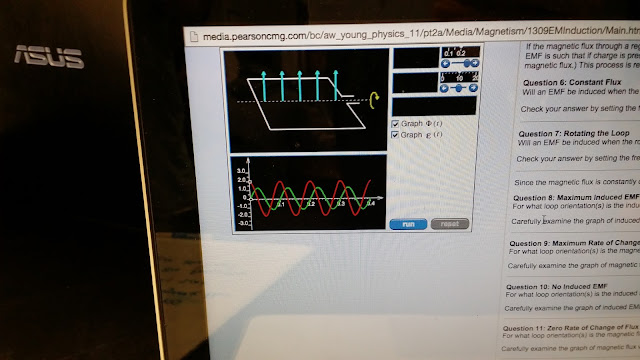Purpose: In this experiment, we take a look at how circuits behave when we just use resistors and capacitors and then inductors, capacitors and resistors under a power supply that operates under some frequency. We examine the behavior of the current and the voltage using Logger Pro.
To begin,we go over the definition of impedance which is dependent on the resistance and the capacitive reactance. We can generalize the impedance as a quantity the behaves similar to a typical resistor. The impedance is defined by the variable Z. We look at Z like a resistor and apply it to Ohm's Law, where the voltage is equal to the current times the impedance. we take a look at this relationship and see what happens if we double our frequancy. We find, with a little algebra, that doubling the frequency will double the current.
We connect an A-C circuit together with a function generator, a capacitor, and an resistor. Using Logger Pro, we were able to measure the behavior of the current and the voltage. We, then, fit the lines generated. These lines are specific to the frequency of 10 Hz. We will later use these values to compare them to the theoretical values.
Like the previous graphs, we measure the behavior of the current and the voltage. The behavior of the current turned out "spikey". We fix this by running Logger Pro to only measure the current without the voltage and altered the measurements taken per second. After the adjustment, the graph was smooth and we fit the equation. The values of the fit equation will also be used later to compare with the theoretical values.
We create a table on the right corner specifically to compare theoretical impedance and experimental impedance. Our impedance is given by the equation on the left top corner and we used the theoretical values on the top to calculate theoretical impedance. We, then, used the values in the experiment, specifically max current and max voltage to calculate impedance. Our impedance is given by the equation in the bottom left where the current rms is equal to the max voltage divided by the product of radical two and the impedance. We just calculate the rms current and plug our values into the equation. We found that our theoretical values for impedance was close to the experimental values at 10 Hz, with just a 3.6% difference. When we look at 1000 Hz, the difference between the impedance is much more substantial as our experimental gave us 39.2 and our theoretical gave us 10.13. This percentage difference was about 224%. The reason why there was a huge difference was because we start to have to account for the resistance within the power supply, which we can assume is around 50 Ohms.
We calculated the phase difference between the voltage vs. time graph and the current vs. time graph. To get this value, we look at the ratio between the difference between the inductive reactance aqnd the capacitive reactance and the resistance.
We finish this experiment by solving for the power dissipated. It is important that we look at the resistor when determining this, as the dissipation of power occurs at the resistor. The graph on the bottom left shows the point of the frequency, which is the maximum. We, also, complete our equation for impedance by factoring in the inductive reactance. The equation for impedance for series circuits is complete at the very top.
L-R-C Circuits
We finish by hooking up an L-R-C circuit. Using the values given, we calculated the current in the circuit and found the resonance frequency. This frequency occurs when the inductive reactance is equal to the capacitive reactance. Our is given in the middle of the board.
Conclusion: We find that the when we calculate the experimental impedance, the values are off because we have to account for the resistance within the power supply at high frequencies. What we generally did was find the current along the circuit and used this current to calculate anything within the circuit because we only work with series circuits and we know that in a circuit in series, the current is the same throughout. With the current, we are able to find practically anything. We, also, go over the idea of resonance frequency. This happens when the inductive reactance and the capacitive reactance are equal and this is also the maximum frequency.













































